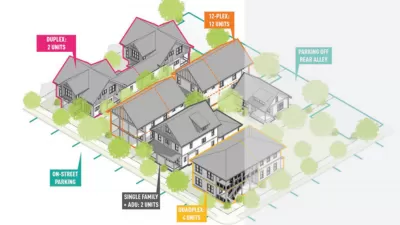Acknowledging the region's dire need for more diverse housing stock, city leaders hope the pre-approved designs, along with necessary zoning reforms, will encourage more construction of 'missing middle housing.'

"Last month Norfolk’s city council approved a Missing Middle Pattern Book full of free designs and schematics for dozens of so-called 'middle housing': duplexes, quadplexes and the city’s iconic 'Norfolk six-packs.'" According to Wyatt Gordon, "[t]he move marks the latest attempt by a Virginia locality to encourage more middle housing, the array of options that lie between single-family detached homes and large apartment buildings."
"The concept of a missing middle in our housing market grew out of the reality that for the last 80 years America has built little housing of a scale between single-family structures and multi-story apartments," housing which tends to be more affordable due to lower land and construction costs. Dan Parolek, principal of Opticos Design and author of Missing Middle Housing, says that "[p]eople often visualize adding more units means that the building will get bigger and bigger, but some of the examples identified in the pattern book demonstrate that you can have a house-scale building with multiple units in it. The concept has been so useful and popular because it gives planners and architects the tools to talk with homeowners about more housing without scary words like density."
Encouraging more missing middle housing takes more than just raising the number of allowable units per lot. "Minimum-lot sizes, mandatory setbacks and off street parking requirements are just a few of the restrictive regulations that have tilted the scales towards single-family, detached housing over the last eight decades. Undoing the layers of laws holding back missing middle housing may prove no easy task." But the pattern book presents an opportunity to streamline the process and expedite permitting through pre-approvals. As housing pressures continue to mount, "cities need to think creatively about how to deliver more housing for residents. Missing middle housing can deliver more attainable housing units at more affordable price points," says Parolek.
FULL STORY: How to bring “missing middle” housing development to Virginia

Alabama: Trump Terminates Settlements for Black Communities Harmed By Raw Sewage
Trump deemed the landmark civil rights agreement “illegal DEI and environmental justice policy.”

Planetizen Federal Action Tracker
A weekly monitor of how Trump’s orders and actions are impacting planners and planning in America.

The 120 Year Old Tiny Home Villages That Sheltered San Francisco’s Earthquake Refugees
More than a century ago, San Francisco mobilized to house thousands of residents displaced by the 1906 earthquake. Could their strategy offer a model for the present?

BLM To Rescind Public Lands Rule
The change will downgrade conservation, once again putting federal land at risk for mining and other extractive uses.

Indy Neighborhood Group Builds Temporary Multi-Use Path
Community members, aided in part by funding from the city, repurposed a vehicle lane to create a protected bike and pedestrian path for the summer season.

Congestion Pricing Drops Holland Tunnel Delays by 65 Percent
New York City’s contentious tolling program has yielded improved traffic and roughly $100 million in revenue for the MTA.
Urban Design for Planners 1: Software Tools
This six-course series explores essential urban design concepts using open source software and equips planners with the tools they need to participate fully in the urban design process.
Planning for Universal Design
Learn the tools for implementing Universal Design in planning regulations.
Clanton & Associates, Inc.
Jessamine County Fiscal Court
Institute for Housing and Urban Development Studies (IHS)
City of Grandview
Harvard GSD Executive Education
Toledo-Lucas County Plan Commissions
Salt Lake City
NYU Wagner Graduate School of Public Service





























